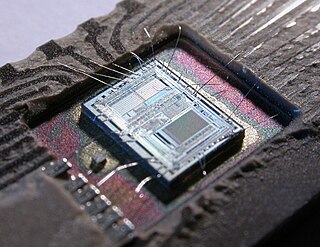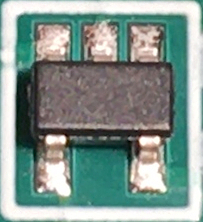Related Research Articles

In digital computers, an interrupt is a request for the processor to interrupt currently executing code, so that the event can be processed in a timely manner. If the request is accepted, the processor will suspend its current activities, save its state, and execute a function called an interrupt handler to deal with the event. This interruption is often temporary, allowing the software to resume normal activities after the interrupt handler finishes, although the interrupt could instead indicate a fatal error.

A microcontroller or microcontroller unit (MCU) is a small computer on a single integrated circuit. A microcontroller contains one or more CPUs along with memory and programmable input/output peripherals. Program memory in the form of NOR flash, OTP ROM, or ferroelectric RAM is also often included on the chip, as well as a small amount of RAM. Microcontrollers are designed for embedded applications, in contrast to the microprocessors used in personal computers or other general-purpose applications consisting of various discrete chips.

An embedded system is a specialized computer system—a combination of a computer processor, computer memory, and input/output peripheral devices—that has a dedicated function within a larger mechanical or electronic system. It is embedded as part of a complete device often including electrical or electronic hardware and mechanical parts. Because an embedded system typically controls physical operations of the machine that it is embedded within, it often has real-time computing constraints. Embedded systems control many devices in common use. In 2009, it was estimated that ninety-eight percent of all microprocessors manufactured were used in embedded systems.
Apple Desktop Bus (ADB) is a proprietary bit-serial peripheral bus connecting low-speed devices to computers. It was introduced on the Apple IIGS in 1986 as a way to support low-cost devices like keyboards and mice, enabling them to be connected together in a daisy chain without the need for hubs or other devices. Apple Desktop Bus was quickly introduced on later Macintosh models, on later models of NeXT computers, and saw some other third-party use as well. Like the similar PS/2 connector used in many PC-compatibles at the time, Apple Desktop Bus was rapidly replaced by USB as that system became popular in the late 1990s; the last external Apple Desktop Bus port on an Apple product was in 1999, though it remained as an internal-only bus on some Mac models into the 2000s.

The MSP430 is a mixed-signal microcontroller family from Texas Instruments, first introduced on 14 February 1992. Built around a 16-bit CPU, the MSP430 was designed for low power consumption, embedded applications and low cost.
NTLDR is the boot loader for all releases of Windows NT operating system from 1993 with the release of Windows NT 3.1 up until Windows XP and Windows Server 2003. From Windows Vista onwards it was replaced by the BOOTMGR bootloader. NTLDR is typically run from the primary storage device, but it can also run from portable storage devices such as a CD-ROM, USB flash drive, or floppy disk. NTLDR can also load a non NT-based operating system given the appropriate boot sector in a file.

A dead man's switch is a switch that is designed to be activated or deactivated if the human operator becomes incapacitated, such as through death, loss of consciousness, or being bodily removed from control. Originally applied to switches on a vehicle or machine, it has since come to be used to describe other intangible uses, as in computer software.

A timer or countdown timer is a type of clock that starts from a specified time duration and stops upon reaching 00:00. An example of a simple timer is an hourglass. Commonly, a timer triggers an alarm when it ends. A timer can be implemented through hardware or software. Stopwatches operate in the opposite direction, upwards from 00:00, measuring elapsed time since a given time instant. Time switches are timers that control an electric switch.

1-Wire is a wired half-duplex serial bus designed by Dallas Semiconductor that provides low-speed (16.3 kbit/s) data communication and supply voltage over a single conductor.

Null modem is a communication method to directly connect two DTEs using an RS-232 serial cable. The name stems from the historical use of RS-232 cables to connect two teleprinter devices or two modems in order to communicate with one another; null modem communication refers to using a crossed-over RS-232 cable to connect the teleprinters directly to one another without the modems. It is also used to serially connect a computer to a printer, since both are DTE, and is known as a Printer Cable.
JTAG is an industry standard for verifying designs of and testing printed circuit boards after manufacture.

A watchdog timer, sometimes called a computer operating properly timer, is an electronic or software timer that is used to detect and recover from computer malfunctions. Watchdog timers are widely used in computers to facilitate automatic correction of temporary hardware faults, and to prevent errant or malevolent software from disrupting system operation.

A KVM switch is a hardware device that allows a user to control multiple computers from one or more sets of keyboards, video monitors, and mouse.
In a computer or data transmission system, a reset clears any pending errors or events and brings a system to normal condition or an initial state, usually in a controlled manner. It is usually done in response to an error condition when it is impossible or undesirable for a processing activity to proceed and all error recovery mechanisms fail. A computer storage program would normally perform a "reset" if a command times out and error recovery schemes like retry or abort also fail.

In systems management, out-of-band management is a process for accessing and managing devices and infrastructure at remote locations through a separate management plane from the production network. OOB allows a system administrator to monitor and manage servers and other network-attached equipment by remote control regardless of whether the machine is powered on or whether an OS is installed or functional. It is contrasted to in-band management which requires the managed systems to be powered on and available over their operating system's networking facilities.
Power cycling is the act of turning a piece of equipment, usually a computer, off and then on again. Reasons for power cycling include having an electronic device reinitialize its set of configuration parameters or recover from an unresponsive state of its mission critical functionality, such as in a crash or hang situation. Power cycling can also be used to reset network activity inside a modem. It can also be among the first steps for troubleshooting an issue.

Intel Active Management Technology (AMT) is hardware and firmware for remote out-of-band management of select business computers, running on the Intel Management Engine, a microprocessor subsystem not exposed to the user, intended for monitoring, maintenance, updating, and repairing systems. Out-of-band (OOB) or hardware-based management is different from software-based management and software management agents.
In computing, a hang or freeze occurs when either a process or system ceases to respond to inputs. A typical example is when computer's graphical user interface no longer responds to the user typing on the keyboard or moving the mouse. The term covers a wide range of behaviors in both clients and servers, and is not limited to graphical user interface issues.

Computers can be classified, or typed, in many ways. Some common classifications of computers are given below.
VPNFilter is malware designed to infect routers and certain network attached storage devices. As of 24 May 2018, it is estimated to have infected approximately 500,000 routers worldwide, though the number of at-risk devices is larger. It can steal data, contains a "kill switch" designed to disable the infected router on command, and is able to persist should the user reboot the router. The FBI believes that it was created by the Russian Fancy Bear group. In February 2022, the CISA announced that a new malware called Cyclops Blink produced by Sandworm had replaced VPNFilter.
References
- 1 2 "Onboard Systems". Basics of Spaceflight. NASA. Retrieved 16 January 2025.